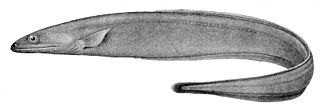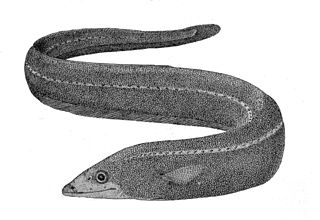
Cutthroat eels are a family, Synaphobranchidae, of eels, the only members of the suborder Synaphobranchoidei. They are found worldwide in temperate and tropical seas.

The grey cutthroat eel, Synaphobranchus affinis, is a cutthroat eel. It was originally described by Albert Günther in 1877. It lives a benthic lifestyle, inhabiting the continental slope and global deep waters including near Portugal, Canary Islands, Morocco, Japan, Australia, and others. It is a marine, deep water-dwelling eel which has been found at depths ranging from 300 to 2300 meters and at temperatures ranging from 3.3 - 11.3 °C. Males can grow to a length of up to 110 centimeters. It is primarily a scavenger, however it also actively hunts small fish and crustaceans.
The snubnosed eel, Simenchelys parasitica, also known as the pug-nosed eel, slime eel, or snub-nose parasitic eel, is a species of deep-sea eel and the only member of its genus. Some authors classify it as the sole member of the subfamily Simenchelyinae of the family Synaphobranchidae, or cutthroat eels, while others place it in its own monotypic family, the Simenchelyidae. It is found in the Atlantic and Pacific Oceans, typically at a depth of 500–1,800 m (1,600–5,900 ft) near the bottom. Although typically a scavenger, it is better known for using its powerful jaws and teeth to burrow into larger fishes as a parasite. This species is harmless to humans and of no interest to fisheries. The generic name Simenchelys translates literally as "pug-nosed eel".

Synaphobranchus is a genus of eels in the cutthroat eel family, Synaphobranchidae. It currently contains the following species:

Leptocephalus is a genus that was used for species of larval eels, called leptocephali, that were thought to be new fish species, or whose adult eel species were not known. Leptocephali differ so much in appearance from their adults that the larvae and adults of eels are not easily matched, and when first discovered, leptocephali were thought to be a distinct type of fishes, but not eels. Because of this, the genus designation of Leptocephalus was used for a while for unidentified leptocephali even after it was known that these were the larvae of eels thus becoming a "wastebasket taxon", but this practice is no longer used. Examples of marine congrid larvae, found in the western Indian Ocean and the Red Sea that were named this way are listed below. Only two species in two families are currently treated as having any validity, though the validity of L. bellottii is strongly in doubt.
Myroconger is the only genus of eels, the thin eels, in the family Myrocongridae. Very little is known about the group.

Dysomma is a genus of marine ray-finned fishes belonging to the family Synaphobranchidae, the cutthroat eels. These eels are found in the Atlantic, Indian and Pacific Oceans.

Dysommina is a genus of marine ray-finned fishes belonging to the family Synaphobranchidae, the cutthroat eels. These eels are known from the Atlantic and Pacific Oceans.
Haptenchelys is a genus of deep-water eel in the family Synaphobranchidae. It contains two species. It is found in the Atlantic Ocean and Pacific Ocean at depths of 2,121 to 4,836 metres.
Atractodenchelys phrix, known under the common name "arrowtooth eel" is an eel in the family Synaphobranchidae. It was described by Catherine H. Robins and Charles Richard Robins in 1970. It is a marine, deep water-dwelling eel which is known from its type locality in the eastern Caribbean, in the western central Atlantic Ocean. It is known to dwell at a depth range of 385–425 metres.

Dysomma anguillare, the shortbelly eel, stout moray, mustard eel or arrowtooth eel, is an eel in the family Synaphobranchidae. It was described by Keppel Harcourt Barnard in 1923. It is a marine, tropical eel which is known from the western Atlantic Ocean and Indo-Western Pacific, including the United States, Venezuela, South Africa, Zanzibar, and Japan. It lives at a depth range of 30 to 270 metres, and inhabits muddy sediments in coastal waters and large rivermouths. Males can reach a maximum total length of 52 centimetres (20 in).
Dysomma brevirostre, the pignosed arrowtooth eel or batnose eel, is an eel in the family Synaphobranchidae. It was described by Luigi Facciolà in 1887. It is a marine, deep water-dwelling eel which is known from the eastern and western Atlantic Ocean, including Madeira Island, the Gulf of Guinea, the Ligurian Sea, Italy, and Florida and Hawaii, USA. It dwells at a depth range of 200 to 1,000 metres, and inhabits soft sediments on the continental slope. Males can reach a maximum total length of 30 centimetres (12 in).
Ilyophis arx is an eel in the family Synaphobranchidae. It was described by Catherine H. Robins in 1976. It is a marine, deep water-dwelling eel which is known from the eastern Pacific and northeastern Atlantic Ocean. It dwells at a depth range of 1,790 to 3,225 metres. Males can reach a maximum total length of 44.7 centimetres (17.6 in).
Ilyophis blachei is an eel in the family Synaphobranchidae. It was described by Luiz Vieria Caldas Saldanha and Nigel Merrett in 1982. It is a marine, deep water-dwelling eel which is known from the northeastern and southeastern Atlantic and southern Indian Ocean. It dwells at a depth range 580 to 2,070 metres, and inhabits the continental shelf. Males can reach a maximum total length of 79.2 centimetres (31.2 in).
Ilyophis saldanhai is an eel in the family Synaphobranchidae. It was described by Emma Stanislavovna Karmovskaya and Nikolai Vasilyevich Parin in 1999, and is the most recently described of the six species in the genus Ilyophis. It is a marine, deep water-dwelling eel which is known from the western central Atlantic Ocean. It is known to dwell at a depth of 3,020 metres (9,910 ft).

The shortdorsal cutthroat eel is an eel in the family Synaphobranchidae. It was described by Albert Günther in 1887. It is a marine, deep water-dwelling eel which is known from the Indo-Pacific and western central Atlantic Ocean, including Zanzibar, Maldives, Australia, Japan, Suriname, and the Gulf of Mexico. It dwells at a depth range of 900 to 3,000 metres, most often between 1,000 to 2,500 metres, and leads a benthic lifestyle, inhabiting the continental slope. Males can reach a maximum total length of 111 centimetres (44 in).
Synaphobranchus dolichorhynchus is an eel in the family Synaphobranchidae. It was described by Einar Hagbart Martin Lea in 1913, originally under the genus Leptocephalus. It is a marine, subtropical eel which is known solely from larval specimens discovered in the northern Atlantic Ocean. It is known to dwell at a depth range of 100 to 150 metres.

The Kaup's arrowtooth eel is an eel in the family Synaphobranchidae. It was described by James Yate Johnson in 1862. It is a marine, deep water-dwelling eel which is known from the Indo-Western Pacific and eastern and western Atlantic Ocean, including the Faroe Islands, Iceland, Cape Verde, the Western Sahara, Nigeria, Namibia, South Africa, Greenland, France, Saint Pierre and Miquelon, the United Kingdom, Ireland, the Philippines, Portugal, Spain, the Bahamas, Brazil, Canada, Cuba, Japan, Australia, Mauritania, Morocco, and Hawaii. It dwells at a depth range of 120 to 4,800 metres, most often between 400 and 2,200 metres, and inhabits the upper abyssal zone on the continental slope. It is intolerant of the temperatures of higher waters. Males can reach a maximum total length of 100 centimetres (39 in).
Synaphobranchus oregoni is an eel in the family Synaphobranchidae. It was described by Peter Henry John Castle in 1960. It is a marine, deep water-dwelling eel which is known from the western central Atlantic Ocean, including the Bahamas, Trinidad and Tobago, Mexico, and the United States. It dwells at a depth range of 512 to 1,900 metres. Males can reach a maximum total length of 111 centimetres (44 in).

Ilyophinae, the arrowtooth ells or mustard eels, is a subfamily of marine ray-finned fishes belongiing to the family Synaphobranchidae, the cutthroat eels. Within its family this subfamily shows greatest number of species and the greatest morphological diversity.






